Chronicle of Asia (part 3)
Chiang Mai and Sukhothai
We take advantage of our stopover in Chiang Mai to try one of the many cooking classes organized there.
Meeting with the teacher who first takes us to the market for a discovery of local ingredients: "Thai onions", mini red onions, "baby eggplants" and "Thai eggplants", green eggplants whose "baby" resemble berries and the "Thai" are the size of a clementine, the "Thai ginger" sweeter than the known ginger and the "finger ginger" in the shape of witch fingers.
We review a thousand spices with unpronounceable names, peppers of all colors and all sizes and "boring vegetables": cabbage, spinach, cauliflower, etc ...
We learn that there are 200 different types of rice in Thailand and we discover how to make coconut milk in a machine from the 1950s by pressing young coconut shavings with water.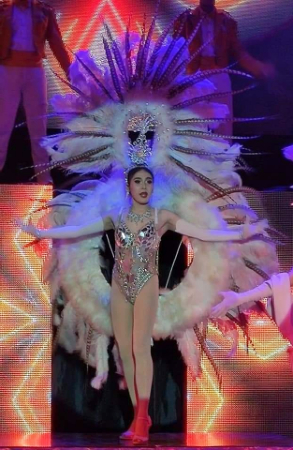
The secret of Thai cuisine?
Everything is fresh!
Impossible to find a supermarket in this country, everything can be bought at the market.
No frozen food, no overpacked and super-sized vegetables, no plastic or canned food, everything is short circuit, organic and zero waste without wanting to.
This is why even the dish bought in the worst boui-boui or tasted in the most dilapidated street stall will be delicious: fresh and "real" food.
The cooking method is always the same: all the ingredients are thrown at the same time in a wok heated to the maximum on a gas stove, just a few minutes and it's ready!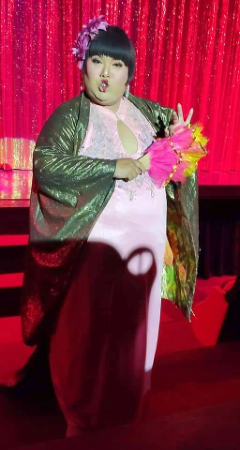
We will therefore spend an entire afternoon cooking and eating: spring rolls, tom yam soup or coconut milk soup, pad thai or pad see ew, different types of curries from which we prepare the dough ourselves, crush all these spices in a stone pestle it makes muscles in the arms! - and, as a dessert after all that, sticky rice sweetened with coconut milk and mango.
As many recipes which I will bring back the book with me, I will just have to adapt the ingredients because I will never find "Thai eggplants" or "finger ginger" in Brussels.
After this food day, cabaret evening. Exclusively made up of ladyboys - some of whom have nothing to envy of the hottest girls - the Siam Dragon Show will make us travel for an hour between the traditions of the different countries of Asia through songs and traditional costumes revisited. Nice!
Direction Sukhotaï then, nearly 400 km to the south, to visit the ruins of what was the first capital of Siam.
Founded in 1238 by Pho Khun Si Nao Nam Thom (yes, all these names for one person) and thus putting an end to the Khmer reign in the region, Sukhothai is today listed as World Heritage by UNESCO.
It is especially to its third king, Pho Khun Ramkhamhaeng (1279-1317), that the city owes its cultural and religious development.
Nicknamed "Rama the Fort", this monarch is a fervent follower of Buddhism - a religion he will help develop in Sukhothai - and a great lover of art.
It is also he who created the first Thai alphabet ... and suddenly thank you, we get nothing on the inscriptions here.
He couldn't have done like everyone else and write in the Roman alphabet, right?!?
The independence of Sukhothai will last until the 15th century when the kingdom is annexed to that of Ayutthaya.
Today, you can still admire the ruins of the ancient city, whose Khmer architecture has been revisited by the many Thai kings: Shiva, Ganesh and the other Hindu gods are recycled into Buddhist temples.
The royal palace and the houses of the inhabitants being then built of wood, we keep no trace of it ...
This can give visitors the impression of the historic park that the ancient Sukhothai was made up only of temples and monasteries, the only brick and laterite buildings.
After an afternoon strolling the alleys of the old town under a blazing sun, we return to New Sukhothai to eat a pad see ew and rice with basil-ginger sauce at a table set on a sidewalk.
We are the only westerners to eat there, that's a good sign.
Delicious makeshift cuisine for less than two euros (for two!), Always with fresh ingredients, fresh, fresh yum!
So much for this culinary and historic expedition in the center of the region.
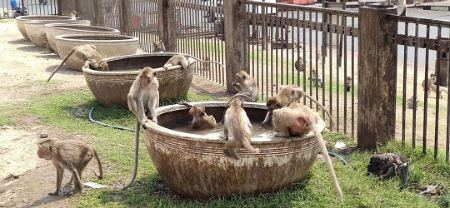
Lopburi
Arrival at the city of monkeys.
Center of Dvaravati Buddhist culture from the 6th to the 11th century, Lopburi then came under Khmer domination before becoming the second capital of the kingdom of Ayutthaya.
But, if Lopburi offers the visitor some beautiful ruins of the time, it is best known for being the city of the monkeys.
Hundreds of monkeys have taken over the city, to the delight of tourists and the total exasperation of the inhabitants.
The latter use all possible means imaginable to prevent the macaques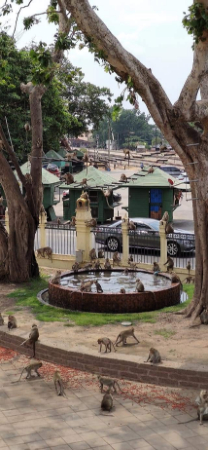 from biting goods and food: sticks, slings, slingshots, ... from biting goods and food: sticks, slings, slingshots, ...
So many homemade weapons that do not discourage these kleptomaniac animals in the least.
I myself have to pay the price: while I posed for a photo by hiding my bottle of water behind my back, one of these critters came to snatch it from my hands!
The dirty beast then crossed the street, opened the fleet by turning the cork with its small legs, drunk holding the bottle with two "hands" then, looking me straight in the eyes, swung the rest a little further .
Sacred thief monkey !!!
We saw a snatch of a shopping bag from the hands of a Thai man who came from the market, others who take the electric cables for a lot of games, we attended fights of monkeys, we were growled passing it too close ... There is even one who tried to climb on my head.
Finally, they are all the same cute these macaques, the mothers strolling with their small, hairless but with already a characteristic face, hung upside down under their belly, the young people who play climbing trees before dropping in basins filled with water, the adults, installed in the shade of the old stones to cleanse themselves by eating the lice they remove or quietly snoozing against each other.
So cute ... but from a distance.
Avoid the monkeys, avoid the stray dogs who jealously guard their end of the sidewalk (bah yes, nobody walks in this city, the least teenager already owns a scooter, suddenly sidewalks and aisles have become the exclusive territory of street hawks ) and ... avoid the groups of Germans who prefer to photograph me - of course, rather than the historic monuments.
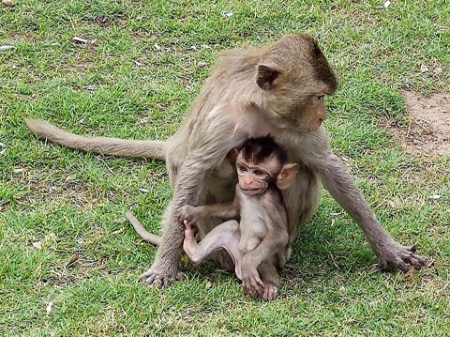 After Lopburi, we continue our journey south to the city of Ayutthaya. After Lopburi, we continue our journey south to the city of Ayutthaya.
Founded in 1350, it became the capital of Siam - or kingdom of Ayutthaya - and was, in the 17th and 18th centuries, one of the largest cities in the world.
It was destroyed in 1767 by the Burmese army.
It was then that Bangkok replaced it as the capital of Siam.
The ruins of Ayutthaya, among the most beautiful of this period, are listed as World Heritage by UNESCO.
For the same reason that in Sukhothaï (the dwellings and palaces were built out of wood, only the religious monuments used stone and laterite), one finds there mainly temples and monasteries.
Khmer, Hindu and - of course - Buddhist influences: a nice cultural mix!
We visit, among others, Wat Ratchaburana whose story is as follows: King Intha Racha died in 1424.
For the sake of not dividing the kingdom, only one of the two eldest sons should take over. Impossible for them to decide who will reign ...
They then organize a duel on the back of elephants in order to decide: the winner will be crowned king of Siam, the loser will be ... dead.
But, fate, the two duelists kill each other during the fight.
It's clever.
It is therefore the youngest son, Somdet Phra Borommarachathirat, who will inherit the throne.
The latter built Wat Ratchaburana in honor of his late father and his two brothers who were a little too intrepid.
A great family story.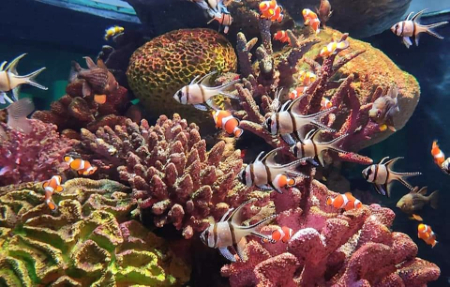
Another nice story: the barge of Queen Sunanda Kumariratana capsized when she went to the Bang Pa In palace.
Physical contact between the people and the monarchs being strictly prohibited and downright taboo, she drowned under the shocked eyes of an impotent crowd.
The force of prohibitions ...
During our Ayutthaian wanderings, we came across the famous elephant rides ...
I thought they were now banned, no.
We saw closely these mistreated animals, chained by the neck to poles in full sun, without water or food, to be then harnessed, mounted by tourists on heavy structures weighing on their sensitive back and led by trainers, hook by hand.
These "bullhooks" (the "hooks" of the hell in question) are in fact nothing other than picks that the masters shamelessly drive into the ears or snout of the elephants. Witness the many scars that discolor their skin. Pffff.
To finish on a slightly more positive note: the magnificent night markets with a thousand flavors. Stalls more enticing than the others with nothing but new things to discover.
So much for these two cities that immerse us in Thai history.
Kanchanaburi and Bangkok
For our last days before the expiration of the visa, small trip to Kanchanaburi at the very infamous bridge over the river Kwai.
Kwaï river which is none other than one of the two tributaries - the Kwaï Noi (the famous Kwaï river, meaning "small tributary" in Thai) and the Kwaï Yai ("big tributary", they did not trample for the names haha) - which join below to form the Mae Klong or Mekong River.
Known by the public on the occasion of the film of the same name released in 1957 (and which, shame on me, I have not yet bothered to watch) derived from the book by Pierre Boulle, the bridge over the river Kwaï was the scene of one of the many human dramas of the second world war.
Yes, because on this side of the world too we suffered until 1945.
It was not Hitler and his fanatic Jewish killers but the Japanese who invaded much of the area as early as 1937.
In Kanchanaburi, they used prisoners of war to build, in less than ten months, a 415 km long railway which was quickly dubbed the "railway of death" because, working 18 hours a day by being malnourished, ill-treated and ill-treated, more than 10,000 prisoners of war have died there.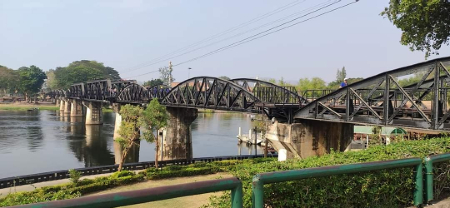
There remains from this period a war museum, a military cemetery where the Western prisoners who died in Kanchanaburi are buried and the bridge as well as the railway itself.
After a ride on the bridge (on the edges of which they installed "safety platforms" so that you don't get run over when a train passes, it's nice) little train ride on the railway of death, which presents a magnificent view of the surrounding valleys z'ait anyway these convicts, such a beautiful view to work, it is not given to everyone.
We also visited a coconut farm where we learned how to harvest coconut juice by hanging receptacles on the leaves that we pierce every day in a different place, how to make sugar by heating the juice thus collected on an old-fashioned wood stove, and how some farmers use trained monkeys to fetch coconuts from the trees for them.
Another mystery has been solved: if the farmers growing coconuts live older than the others it is because coconut milk is estrogen.
Yes Yes. Do you want to stay young longer?
Keep baby skin even at 80? Spread coconut milk, stuff yourself with coconut sugar, cook with coconut juice and eat coconut flesh.
Yes, it works.
When you know that soy also contains estrogens and that these two products are the staple of the diet in Asia, you will no longer wonder why Asian girls seem young longer.
(euuuuh before you go to buy twenty liters of coconut milk to replace your day creams and other anti-wrinkle products, I want to clarify that this information comes from the aforementioned farmers looking to sell us their coconut beauty products. .. a reliable source no doubt).
We then return to Bangkok for a few days of intensive shopping, we will pass through all social classes: first the very chic shopping centers next to the hotel: the Siam Discovery, the Siam Experience, the Siam I don't know what (rather chauvinistic these Thais in fact there is always Siam in the name, in case you have forgotten in which country you are) if you want, you can walk for a long time from one shopping center to another in a hype atmosphere , felted and air-conditioned to death.
We will come across Sea life, "one of the largest aquariums in the world", which makes you want to free the cattle in save Willy mode.
In another genre, the largest market in the world ... which in my opinion is not that big ...
What is great is especially the amount you can spend there ...
But we have seen that Thais love to say that they have the greatest in all areas.
And finally, to end this shopping spree, the floating market of Damnoen Saduak, a few kilometers from the capital, where either you learn to negotiate or you are tricked. I still managed to get for 200 bath (less than 6 €) a dress whose starting price was 1200 bath (about 40 €). It must be said that this floating market is a great experience: you walk in a boat between the stalls installed on the edge of the canals and the merchant boats.
All sellers also have a practical little tool that allows them to attract you by harpooning your boat, without always asking your permission or verifying that you are indeed interested in their display.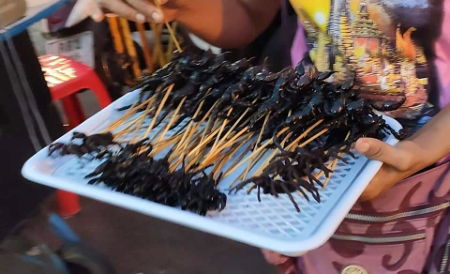
Tired of places intended for tourists, we went to eat in street stalls frequented only by locals.
This gave us the opportunity to try on the menu exclusively written in Thai the version of Google translate which allows you to translate the text of an image.
We tested, among other things, "fresh yum"
(something tells me it's not really what they put on the menu, lol, thanks Google).
On the last evening, in a version of me-the-fart-with-my-new-purchasing-power, we embark on the Chao Princess Cruise, a dinner cruise of two and a half hours on the Mekong River through all cool places in Bangkok illuminated at night.
Next step: Singapore! |
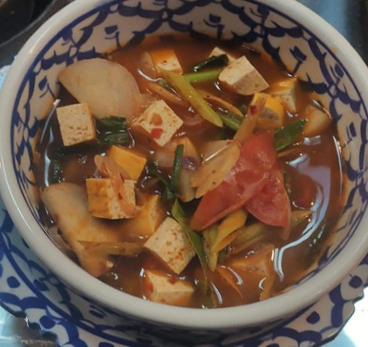



 from biting goods and food: sticks, slings, slingshots, ...
from biting goods and food: sticks, slings, slingshots, ... After Lopburi, we continue our journey south to the city of Ayutthaya.
After Lopburi, we continue our journey south to the city of Ayutthaya.

